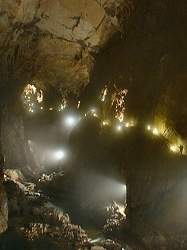Largest Cave Passage

 Skocjanske Jame (Skocjan Caves), Slovenia.
Skocjanske Jame (Skocjan Caves), Slovenia.
 Skocjanske Jame (Skocjan Caves), Slovenia.
Skocjanske Jame (Skocjan Caves), Slovenia.A passage is a morphological feature of a cave: a tunnel-like structure, with about the same height and width for some elongation. At the first this seems to be a strange idea, that nature would produce such a special form of a natural hollow. But as a matter of fact, passages are the common thing, not the special. That is a result of the way most caves are formed. Karst caves are often formed or at least altered by underground rivers. Those rivers work more or less the same way all along their underground bed. The result is a gorge-like passage with similar erosional forms as above ground gorges.
Actually it is impossible to make a ranking based on three dimensions. There may be one passage which is wider, another one which is higher, so which one is the biggest? And it gets more complicated if you add the length, is a long but small passage bigger than a huge and very short one? The solution could be to multiply all three values to get the volume. Unfortunately this number would be extremely inaccurate as the cave passage has a rather complex form. As a result there is actually no way to compare passages unless one is bigger in all three dimensions.
The discussion on the "biggest cave" was actually started by National Geographic, who published an article titled "the biggest cave of the world" on Hang Sơn Đoòng. They never explained how the did the comparison, even the dimensions were vague, estimated by the photographer or based on early raw survey data. The British team which explored the cave has published more accurate numbers after their second expedition which are less enthusiastic.
To understand why it is so hard to determine the volume of a cave you need to know how caves are surveyed. The technique used is quite simple and the same used for surveying above ground: you start with a point and then "shoot" down the passage to the next point measuring distance, direction and inclination. Then you repeat this again and again. The result is a sort of backbone or skeleton of the passage. You can draw vertical and horizontal view by measuring the distance to the wall from this backbone and connecting the dots. The main problem is: there is only the backbone and the dots. As a result the only actual numbers we get as a result of a survey are something called length which is the sum of all measurements and the lowest and highest point of the cave which gives us the vertical range. All other numbers are just guestimates.
With this in mind you should interpret the following list as a collection of extremely big caves without a strict ranking.
| Height | Width | Length | Name | Description |
|---|---|---|---|---|
| 180m | 91m | 3,000m |
 Hang Sơn Đoòng Hang Sơn Đoòng
|
The huge passage has a rather small entrance, but the passage behind has a general size of 180 m high and 100 m wide, with some parts even 175 m wide. There are two dolines and the passage is even bigger around those dolines, reaching a height of 250 m. |
| 120m | 152m | 1,931m |
 Gua Payau
(Deer Cave) Gua Payau
(Deer Cave)
|
Deer Cave is a huge passage, a through cave with the general dimension of 120 m high and 100 m wide. Both portals are huge, more or less of the same size, but the bigger one is also said to be the biggest cave entrance of the world. Actually it is also number two in this respect. |
| 146m | 60m | 2,600m |
 Skocjanske Jame (Skocjan Caves) Skocjanske Jame (Skocjan Caves)
|
The Skocjanske Jame of the Classical Karst definitely plays in the same league, although it is probably not number three. And it is the best accessible of all huge passages, as it is well developed as a show cave and located in the heart of Europe. The Martel Chamber, which is not on the tour, is one of the largest underground chambers in Europe, 2.2 milllion m³, 146 m in height, 120 m wide and 300 m long. |
 Search DuckDuckGo for "Largest Cave Passage"
Search DuckDuckGo for "Largest Cave Passage" Conquering an Infinite Cave (27-JAN-2019)
Conquering an Infinite Cave (27-JAN-2019)
 Index
Index Topics
Topics Hierarchical
Hierarchical Countries
Countries Maps
Maps